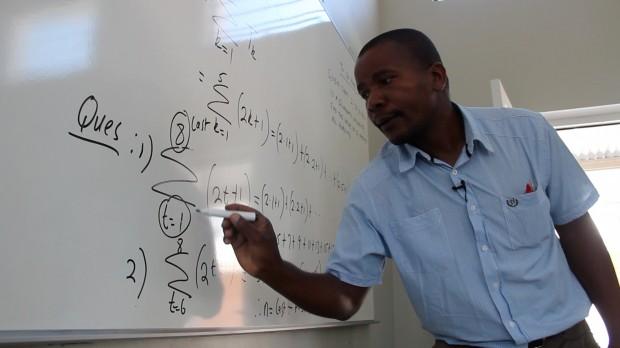School Year Blog: Are You Smarter Than a COSAT Tenth-Grader?
Mr. Shonhiwa, a math teacher at COSAT, says his students don’t have time to prepare for math competitions.
This blog post is part of a year-long series, School Year: Learning, Poverty, and Success in a South African Township. Read more on the School Year Blog.
A few weeks ago, some COSAT students participated in a math competition at the University of Cape Town. About 8,000 students from the region were involved.
As an unrepentant lover of numbers and a former math competition junkie (I still have my “mathlete” t-shirt), I was pretty excited about this news.
“How did it go?” I asked a few girls the next day.
They grimaced.
“It was okay,” said Thembakazi, a sophomore. “The first ten questions were pretty easy, but then they got hard,” she said. They were given 75 minutes to answer 30 questions, each a bit more difficult than the previous.
Mr. Shonhiwa, a math teacher who traveled with the students, said COSAT students rarely win awards at the competition. But he said it’s not because they aren’t capable.
“We just don’t have time to prepare,” Mr. Shonhiwa said. “Many of the questions require special training and preparation. Our kids just don’t have time.”
Other high schools in South Africa sponsor math clubs that meet after school. But COSAT follows a longer day than most schools, and many students have lengthy commutes, some on foot. When you factor in the need to get home before dark, and daily chores, there isn’t much of a window for the kids to practice for a math competition after school hours.
Nonetheless, the girls felt they had done pretty well, and said they are looking forward to next year.
I got my hands on a copy of the test and thought it might be fun to share some of the questions. Here are five that Thembakazi and her friends dubbed “pretty easy.”
Are you smarter than a COSAT tenth-grader? Take this short quiz to find out.
Question #1
How many Wednesdays can there be, at most, in 52 consecutive days?
a. 5
b. 6
c. 7
d. 8
e. 9
Question #2
When (2x + 1)(3x-5)(x+1) is multiplied out, the coefficient of x is:
a. -12
b. 7
c. -8
d. 4
e. 11
Question #3
Which two terms must be removed from the sum 1/2 + 1/4 + 1/6 + 1/8 + 1/10 + 1/12 so that the sum of the remaining terms is equal to 1?
a. 1/4 + 1/8
b. 1/4 + 1/12
c. 1/8 + 1/12
d. 1/6 + 1/10
e. 1/8 + 1/10
Question #4
Coins must be placed on a 2 x 9 grid so that each square of the grid either contains a coin, or shares an edge with a square that contains a coin. The smallest number of coins needed is:
a. 4
b. 5
c. 6
d. 7
e. 8
Question #5
In the grade 9 math class there are three boys for every two girls. The average age of the boys is 14 years and 2 months and the average age of the girls is 13 years and 4 months. What is the average age of the whole class?
a. 13 years and 6 months
b. 13 years and 8 months
c. 13 years and 9 months
d. 13 years and 10 months
e. Not enough information
(Correct answers in the comments below)
Our coverage reaches millions each week, but only a small fraction of listeners contribute to sustain our program. We still need 224 more people to donate $100 or $10/monthly to unlock our $67,000 match. Will you help us get there today?
